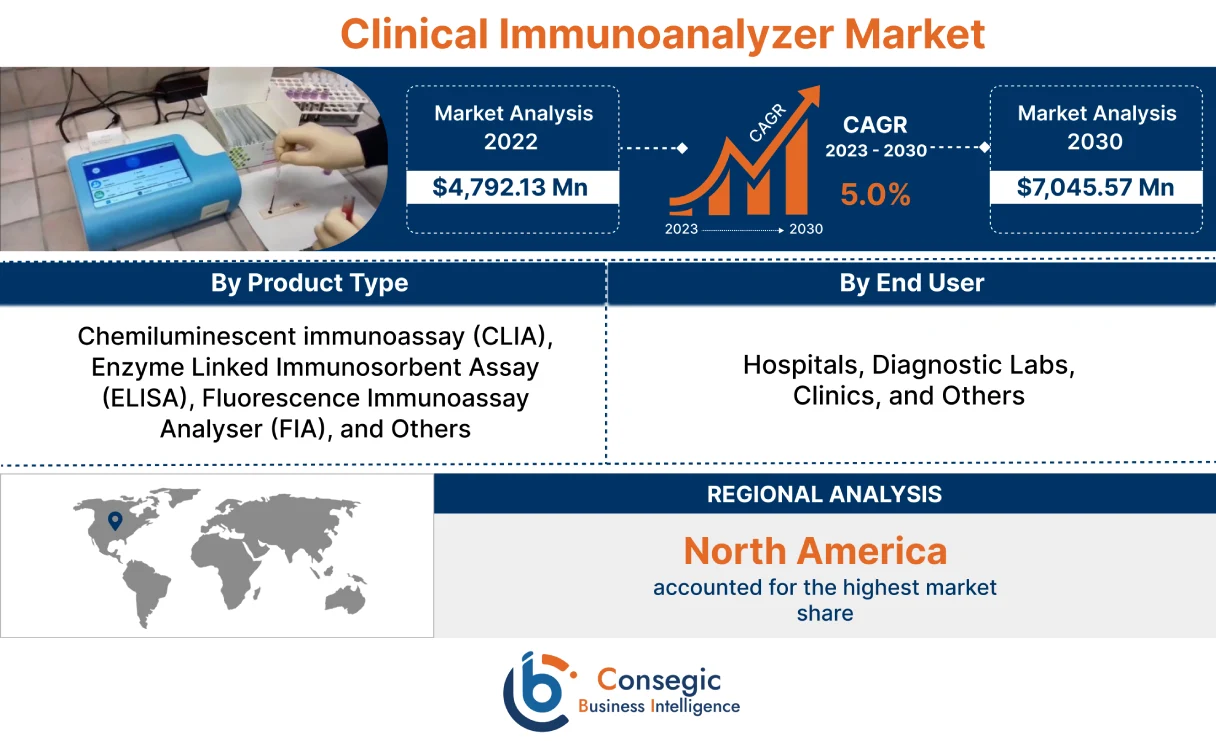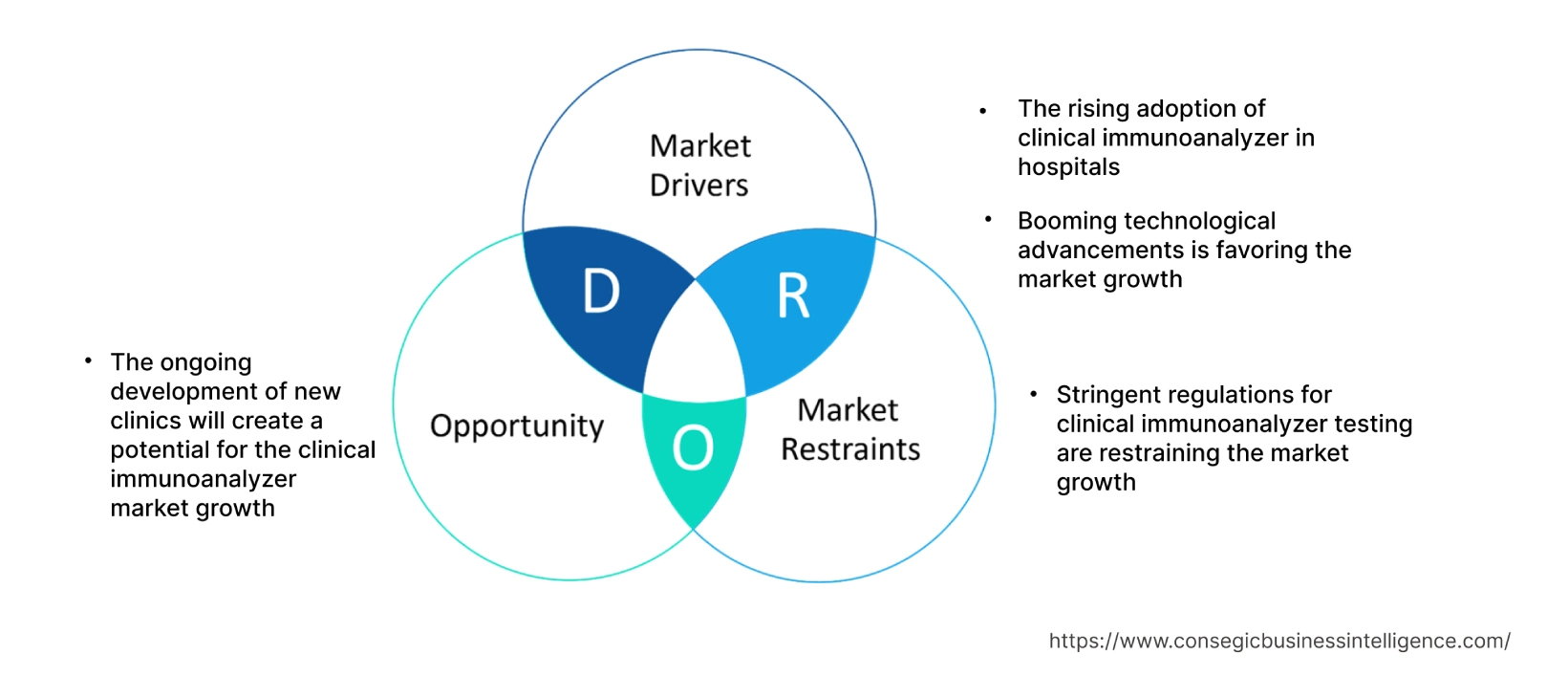- Summary
- Table Of Content
- Methodology
Clinical Immunoanalyzer Market Introduction :
Consegic Business Intelligence analyzes that the clinical immunoanalyzer market is growing with a healthy CAGR of 5.0% during the forecast period (2023-2030), and the market is projected to be valued at USD 7,045.57 Million by 2030 from USD 4,792.13 Million in 2022.
Clinical Immunoanalyzer Market Definition & Overview:
The clinical immunoanalyzer is a diagnostic equipment that utilizes immunoassay processes such as enzyme-linked fluorescent immunoassay, chemiluminescence immunoassay, radioimmunoassay, and enzyme-linked immunosorbent assay to efficiently detect specific analytes in blood or fluids (RIA). Immunoassay analyzers are used to identify and detect the concentration of specific substances in a sample, usually using an antibody as a reagent. These devices can perform a variety of diagnostic tests.
The clinical immunoanalyzer products deploy automated chemical analyzers. This results in a reduction in manual interventions and improves the workflow. The clinical immunoanalyzer is frequently utilized for determining bacterial, protein, or viral toxins, and drug concentration, among others. Furthermore, a clinical immunoanalyzer is vital for detecting viral toxins and bacterial infections. As a result, a clinical immunoanalyzer is ideal for various end users such as hospitals, diagnostic labs, clinics, and others.
Clinical Immunoanalyzer Market Insights :
Key Drivers :
The rising adoption of clinical immunoanalyzer in hospitals
Clinical immunoanalyzer are employed in hospitals for examining bacterial & viral toxins, proteins, infectious diseases, drug concentration, testing allergies, endocrine hormones, and cardiac markers. The opening of new hospitals at the global level is attributed to factors such as increasing private players' investment, government initiatives, and others. In August 2022, Amrita Hospital, with a capacity of 2,600-bed was launched in India. The Amrita Hospital is equipped with cutting-edge technology and laboratories. Hence, the recently inaugurated hospitals are driving the demand for clinical immunoanalyzer to identify and detect the concentration of specific substances. Thus, the advancement in the adoption of clinical immunoanalyzer in hospitals is favoring market growth.
Booming technological advancements is favoring the market growth
The leading industry players in the clinical immunoanalyzer industry are prominently utilizing an approach for innovations in clinical immunoanalyzer, which are utilized for ensuring minimized manual intervention, quantifying specific analytes in blood, and others. As a result of this, companies dealing in the clinical immunoanalyzer product range are developing new products with updated new technology. Thus, the introduction of new products with upgraded technology is boosting the expansion of the global clinical immunoanalyzer market. For instance, in July 2023, Anbio Biotechnology Ltd., headquartered in the United Kingdom launched a fluorescent immunoassay analyzer for quick point-of-care testing. Therefore, the innovations in clinical immunoanalyzer ensure rapid testing results, which, in turn, is driving the market growth.
Key Restraints :
Stringent regulations for clinical immunoanalyzer testing are restraining the market growth
Clinical immunoanalyzer are medical devices, which have direct contact with the end-use customers. As a result, there are various stringent government regulations associated with clinical immunoanalyzer. This, in turn, is restraining the growth of the market. For illustration, clinical immunoanalyzer as per the class A equipment in GB 4824 regulation. In addition, appropriate testing measures must be deployed to ensure the clinical immunoanalyzer is safer. Henceforth, the above government regulations for the manufacturing and testing of clinical immunoanalyzer are posing a major bottleneck for the growth of the clinical immunoanalyzer market at the global level during the projected forecast period.
Future Opportunities :
The ongoing development of new clinics will create a potential for the clinical immunoanalyzer market growth
Clinical immunoanalyzer has various beneficial functions such as minimized training requirements, improved reliability, and others. These features make clinical immunoanalyzer an ideal solution for clinics. For instance, in May 2022, Community Health Clinic (CHC), a non-profit health clinic in Indiana, the United States commenced the construction of a 15,000-square-foot clinic in the country. The development of a new Community Health Clinic (CHC) is aimed at increasing the number of healthcare facilities catering to a larger population. As a result, the development of new clinics will accelerate the demand for clinical immunoanalyzer to ensure superior reliability in samples. This prominent factor will propel the revenue growth of the clinical immunoanalyzer market in the forecast years.
Clinical Immunoanalyzer Market Report Insights :
| Report Attributes | Report Details |
| Study Timeline | 2017-2030 |
| Market Size in 2030 | USD 7,045.57 Million |
| CAGR (2023-2030) | 5.0% |
| By Product Type | Chemiluminescent immunoassay (CLIA), Enzyme Linked Immunosorbent Assay (ELISA), Fluorescence Immunoassay Analyser (FIA), and Others |
| By End User | Hospitals, Diagnostic Labs, Clinics, and Others |
| By Region | North America, Europe, Asia-Pacific, Latin America, and Middle East & Africa |
| Key Players | Roche Diagnostics, Abbott, Beckman Coulter, BioMerieux, Randox Laboratories, Tosoh Corporation, Werfen Life, DiaSorin, BioMerieux, and Ortho-Clinical Diagnostics |
Clinical Immunoanalyzer Market Segmental Analysis :
Based on the Product Type :
The product type segment is categorized into chemiluminescent immunoassay (CLIA), enzyme linked immunosorbent assay (ELISA), fluorescence immunoassay analyser (FIA), and others. In 2022, the chemiluminescent immunoassay (CLIA) segment accounted for the highest market share in the clinical immunoanalyzer market. Chemiluminescence immunoassay is a vital assay that amalgamates the chemiluminescence technique in combination with immunochemical reactions. The primary benefit of chemiluminescent immunoassays is the simplicity of the detector to record data. Additionally, chemiluminescent immunoassays emit light, which eliminates the need for excitation from a light source or a detector for a diverse range of wavelengths not in the visible spectrum. Hence, chemiluminescent immunoassays are ideal for application in diagnostic labs, hospitals, and many more. Thus, the above benefits associated with chemiluminescence immunoassay are amplifying the adoption of the product in hospitals, clinics, and others to ensure superior accuracy in the samples. This, in turn, is supplementing the market growth.
However, the enzyme linked immunosorbent assay (ELISA) segment is projected to be the fastest-growing segment during the forecast period. This is due to the increasing development of a new range of enzyme linked immunosorbent assay, which is fostering segmental growth. For instance, in March 2022, Promega Corporation, a healthcare manufacturer in the United States introduced Lumit Immunoassays for enzyme linked immunosorbent assay users.
Based on the End-User :
The end user segment is categorized into hospitals, diagnostic labs, clinics, and others. In 2022, hospitals segment accounted for the highest market share of 38.48% in the overall clinical immunoanalyzer market. The clinical immunoanalyzer is equipped with prominent features such as maximum system uptime, improved reliability, intuitive interfaces, easy-to-use features, minimized training requirements, streamlined inventory, and management tasks. As a result, clinical immunoanalyzer is frequently employed in hospitals to ensure superior reliability, excellent scalability, and simple processing. For instance, in 2022, various hospital construction projects commenced at the global level, including USD 538 million Gainesville Hospital Expansion project in the United States (project completion year 2030), USD 800 million Techo Santepheap Phnom Penh Covid-19 Treatment Center project in Cambodia (project completion year 2030), USD 1,760 million Lok Ma Chau Emergency Hospital Development in China (project completion year Q4 2023), among others. Thus, the development of new hospitals will accelerate the demand for clinical immunoanalyzer to enable superior simplification in sampling. This factor will create a potential for market growth.
However, the clinics segment is expected to be the fastest-growing segment during the forecast period. This growth is attributed to factors such as increasing investment in new clinics, government initiatives for public clinics, and others.
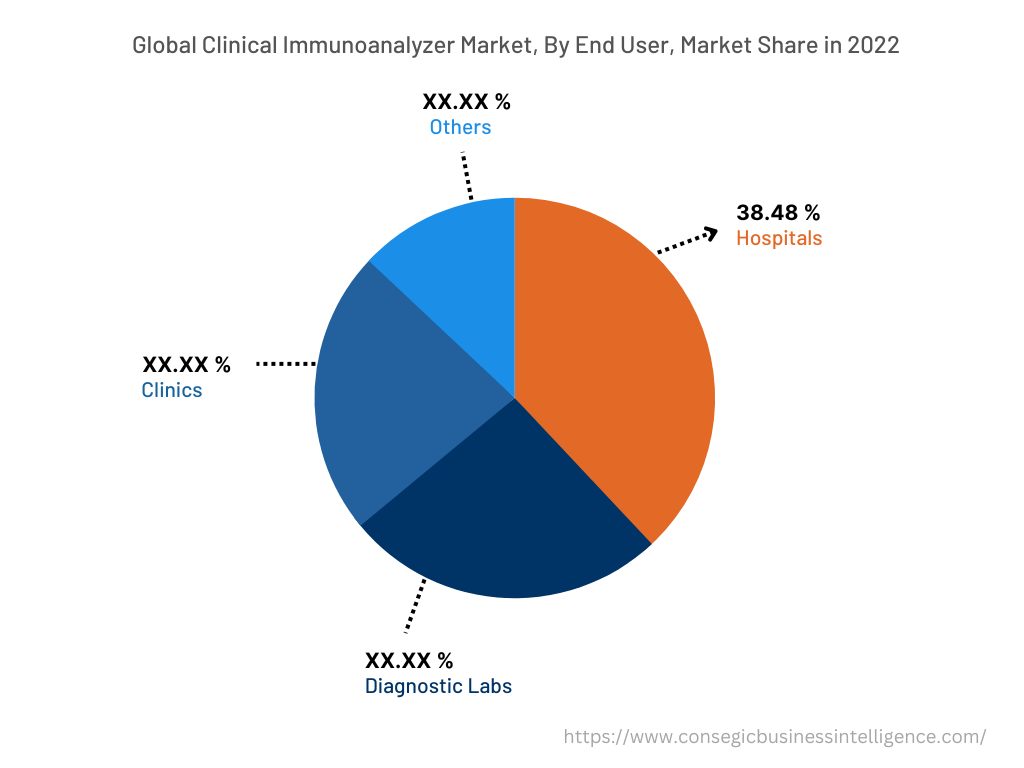
Based on the Region :
The regional segment includes North America, Europe, Asia Pacific, Middle East and Africa, and Latin America.
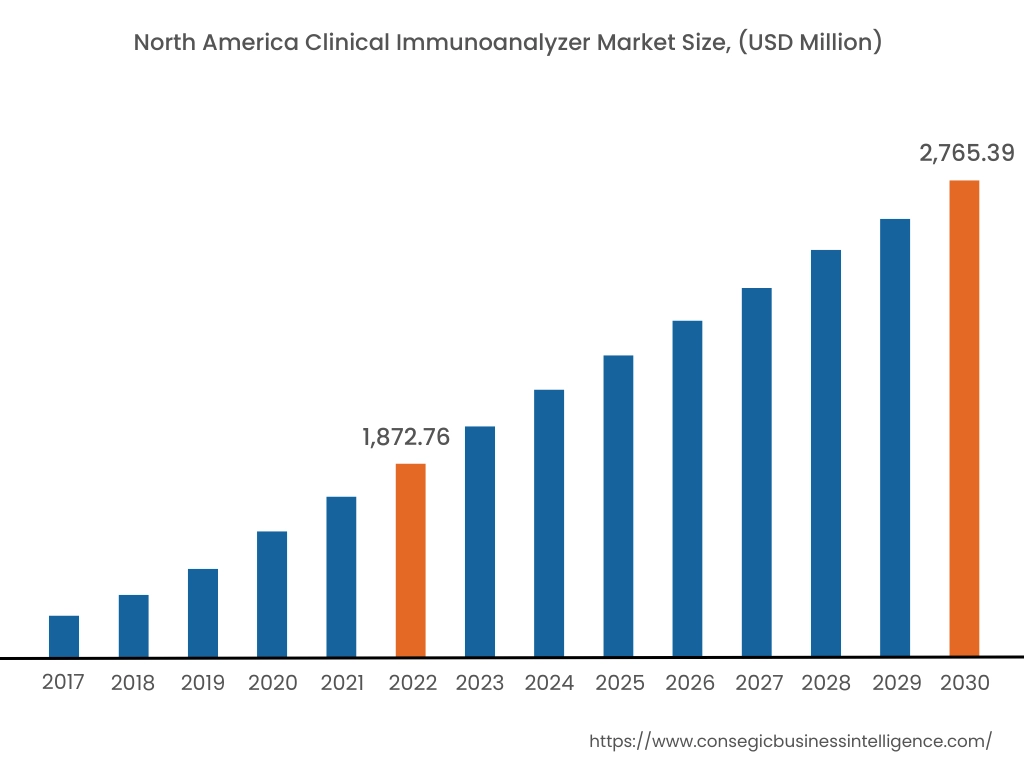
In 2022, North America accounted for the highest market share at 39.08% and was valued at USD 1,872.76 million, and is expected to reach USD 2,765.39 million in 2030. In North America, the U.S. accounted for the highest market share of 69.65% during the base year of 2022. The increasing demand for rapid sampling, accurate examination of protein, and others are some of the prominent factors driving the development of new clinical immunoanalyzer in the North America region. For instance, in July 2023, Fapon Biopharma, a United States-based player dealing in the chemiluminescent immunoassay product range unveiled a new range of chemiluminescence immunoassay systems named Shine i8000/9000. The Shine i8000/9000 is equipped with a fully automated analyzer and superior speed with an ultra-high throughput of 900 tests per hour. Likewise, the product empowers its partners to construct premium clinical diagnostic solutions. Therefore, the introduction of a new range of clinical immunoanalyzer in North America is benefiting the market growth in the region.
Furthermore, Asia Pacific is expected to witness significant growth over the forecast period, growing at a CAGR of 5.7% during 2023-20230. This is due to the exponential growth in the adoption of clinical immunoanalyzer by end users such as hospitals, diagnostic labs, and clinics, among others.
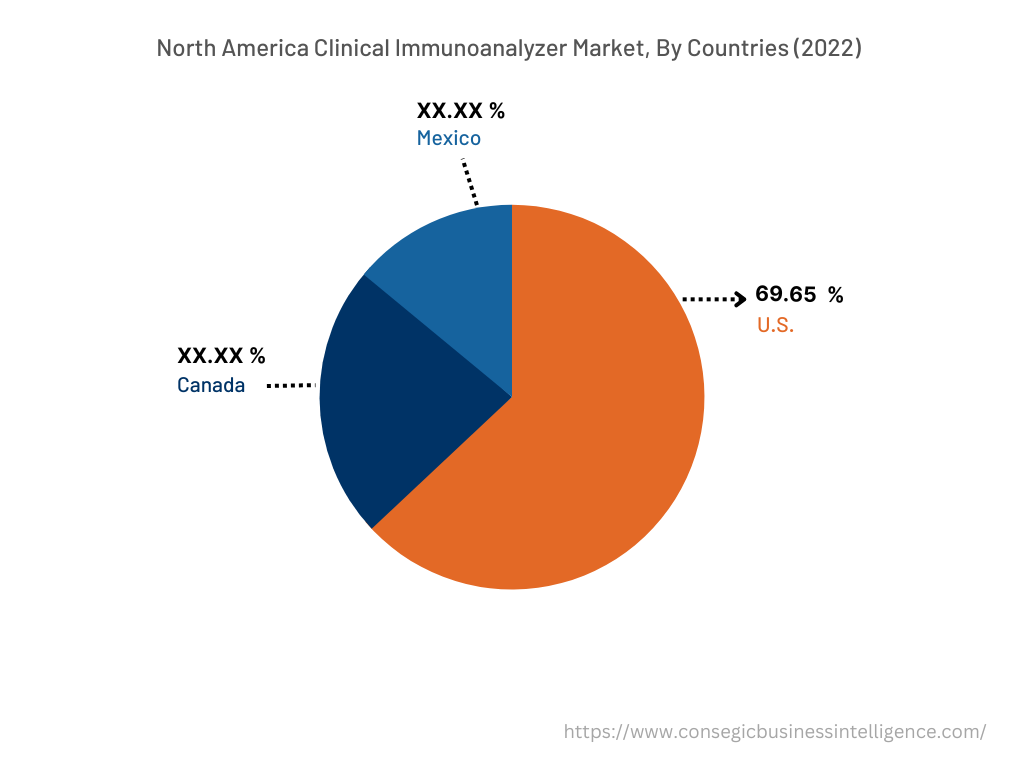
Top Key Players & Market Share Insights:
The clinical immunoanalyzer market is highly competitive, with several large players and numerous small and medium-sized enterprises. These companies have strong research and development capabilities and a strong presence in the market through their extensive product portfolios and distribution networks. The market is characterized by intense competition, with companies focusing on expanding their product offerings and increasing their market share through mergers, acquisitions, and partnerships. The key players in the market include-
- Roche Diagnostics
- Abbott
- DiaSorin
- BioMerieux
- Ortho-Clinical Diagnostics
- Beckman Coulter
- BioMerieux
- Randox Laboratories
- Tosoh Corporation
- Werfen Life
Recent Industry Developments :
- In February 2023, Charles River Laboratories International, Inc., a healthcare manufacturer based in the United States launched the IgY-based ELISA Kit. The prime aim of the new product launch was to enhance the efficiency and efficacy of host cell protein (HCP) assay development. Henceforth, the development of a new range of products will accelerate the market share growth of the company in the upcoming years.
Key Questions Answered in the Report
What was the market size of the clinical immunoanalyzer industry in 2022? +
In 2022, the market size of clinical immunoanalyzer was USD 4,792.13 million
What will be the potential market valuation for the clinical immunoanalyzer industry by 2030? +
In 2030, the market size of clinical immunoanalyzer will be expected to reach USD 7,045.57 million.
What are the key factors driving the growth of the clinical immunoanalyzer market? +
The rising adoption of clinical immunoanalyzer in hospitals is bolstering the market growth.
What is the dominating segment in the clinical immunoanalyzer market by end user? +
In 2022, the hospitals segment accounted for the highest market share of 38.48% in the overall clinical immunoanalyzer market.
Based on current market trends and future predictions, which geographical region is the dominating region in the clinical immunoanalyzer market? +
North America accounted for the highest market share in the overall clinical immunoanalyzer market.
